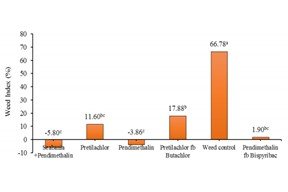Evaluation of different weed management practices in dry direct seeded spring rice at Baniyani, Jhapa, Nepal
Abstract
A field experiment was conducted during the spring season of 2020 to evaluate the different weed management practices in dry directed seeded spring rice under Prime Minister Agriculture Modernization Project (PMAMP) super zone at Baniyani, Jhapa. The experiment was laid out in randomized complete block design (RCBD) with seven weed management related treatments and three replications. The treatments consisted of pre-emergence application of Pretilachlor, pre-emergence application of Pendimethalin, pre-emergence application of Pretilachlor fb post-emergence butachlor pre-emergence application of Pendimethalin fb post-emergence Bispyribac Na, Sesbania co-culture along with pre-emergence application of Pendimethalin along with two control treatments (weedy free and weedy check). The rice variety Hardinath-1 was used in the experiment. Data regarding the weed flora, weed density, weed dry weight, growth, yield attributes and yield were recorded and analyzed. The highest number of effective tillers per m2 (371.51) and number of grains per panicle (145.43) were obtained in Pendimethalin treated plot and were statistically as par with Sesbania co-culture + Pendimethalin (363.44 m-2 and 140.54 respectively). Higher and statistically similar grain yield was observed in Sesbania co- culture + Pendimethalin (4870kg ha-1) and Pendimethalin treated plots (4780 kg ha-1). The experiment concluded that there was reduction in yield by 66.78 percent due to presence of weed as compared to weed free. Pre-emergence application of Pendimethalin was most beneficial in terms of gross returns, net returns and B:C ratio compared to other weed management practices and hence was most economical.
Keywords:
Dry direct seeded rice, Pre and Post emergence, Sesbania co-culture, Weed management practicesDownloads
References
Ali, R.I., Saleem, M. U., Akhter, M. and Iqbal, N. (2014). Effective Weed Management in Dry Direct Seeded Rice. Pakistan Journal of Weed Science, 20(4): 519–529.
Azmi, M., Chin, D.V., Vongsaroj, P. and Johnson, D.E. (2005). Emerging issues in weed management of direct-seeded rice in Malaysia, Vietnam, and Thailand. In K. Toriyama, K. L. Heong, & B. Hardy (Eds.), Proceeding of the world Rice Research Conferrence. Rice is Life: Scientific Perspectives for the 21st Century. International Rice Research Institute 2005.
Bhattarai, R.K., Gautam, D.D., Ranjit, J.D. and Chauhan, B.S. (2016). Effect of Herbicides and Sesbaniaco- Culture on Weed Management and Grain Yield of Direct Seeded Rice Variety Khumal-4 at Khumaltar Condition, Nepal. Agronomy Journal of Nepal, 4:121–127, https://doi.org/https://doi.org/10.3126/ajn.v4i0.15534
Bhurer, K.P., Yadav, D., Ladha, J., Thapa, R. and Pandey, K. (2013). Effect of integrated weed management practices on performance of dry direct seeded rice (Oryza sativa L.). Agronomy Journal of Nepal, 3: 53–63, https://doi.org/10.3126/ajn.v3i0.9006
FAOSTAT. (2018). Statistical information. Food and Agriculture Organization.
Hossain, M., Begum, M., Rahman, M. and Akanda, M. (2016). Weed management on direct-seeded rice system - a review. Progressive Agriculture, 27(1): 1–8, https://doi.org/10.3329/pa.v27i1.27526
Kalita, J., Ahmed, P. and Baruah, N. (2020). Puddling and its effect on soil physical properties and growth of rice and post rice crops: A review. Journal of Pharmacognosy and Phytochemistry, 9(4): 503-510.
Kumar, V. and Ladha, J.K. (2011). Direct Seeding of Rice. Recent Developments and Future Research Needs. Advances in Agronomy, 111: 297–413, https://doi.org/10.1016/B978-0-12-387689-8.00001-1
Marasini, D., Sah, S.K., Marahatta, S. and Dhakal, S. (2020). Weed dynamics and productivity of dry direct seeded rice in relation to tillage and weed
management practices. In Journal of Agriculture and Forestry University 4: 101-108
MOALD. (2020). Statistical Information on Nepalese Agriculture (2018/19).
Moody, K. (1991). Weed Management in rice. In Handbook of Pest Management in Agriculture. 301–328. CRC Press.
Raj, S.K. and Syriac, E.K. (2017). Weed management in direct seeded rice: A review Weed management in direct seeded rice: A review. Agricultural Reviews, 1 (1): 86–88, https://doi.org/10.18805/ag.v0iOF.7307
Sharma, M. (2013). Weed dynamics and yield of dry of dry direct seedded rice under different weed management practices at Rampur, Chitwan.
Shekhawat, K., Rathore, S.S. and Chauhan, B.S. (2020). Weed Management in Dry Direct-Seeded Rice: A Review on Challenges and Opportunities for Sustainable Rice Production. Agronomy, 10(9): 1264, https://doi.org/10.3390/agronomy10091264
Subbaiah, S.V. (2008). Studies on weed and water management in direct seeded rice. In L. Baños, Y. Singh, V. P. Singh, B. Chauhan, A. Orr, A. M. Mortimer, D. E. Johnson, & B. Hardy (Eds.), Direct Seeding of Rice and Weed Management in the Irrigated Rice-Wheat Cropping System of the Indo-Gangetic Plains.177–189.
Valverde, B., & Gressel, J. (2005). Implication and containment of gene flow from herbicide resistant rice (Oryza sativa). Proceeding of 20th Asian Pacific Weed Sciences Society, 63–84.
Yadana, S.M., Myat Yadanar, S., Swe Mar, S., Than, A.A. and Ngwe, K. (2018). Effect of Nitrogen and Potassium on Yield and Yield components of Rice. Management of Nutrients for Improved Profitability and Sustainability of Crop Production in Central Myanmar.

Published
How to Cite
Issue
Section
Copyright (c) 2020 Agriculture and Environmental Science Academy

This work is licensed under a Creative Commons Attribution-NonCommercial 4.0 International License.

